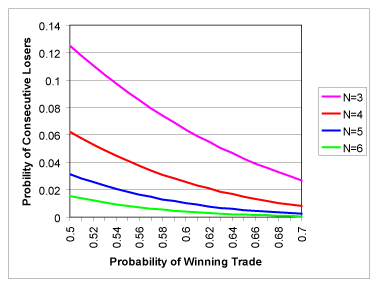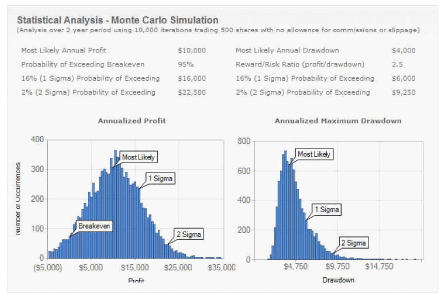 |
January, 2020 | ||||
 |
 |
||||
|
Developer/CTA Interview
John F. Ehlers
Presitent, Mesa Software, Inc.
Program(s) Developed: eMiniZ Alerts E-Mini stock Index trading signals
Interview Date: March, 2007 Interviewed by John F. Gallwas - Founder of Striker Securities, Inc.
This is a follow-up to our November 2006 interview with John Ehlers, President of Mesa Software, Inc., who pioneered the Mesa method of market cycles. Mr. Ehlers is a system software engineer. He and his partners Ric Way, the CTO for the TAOS (Technical Analysis Object System) Group, and Marty Johnson, who is President of Beacon Solutions, Inc , a software development and integrations company, have developed the eMiniZ ? trading system for the e-mini index markets.
By way of introduction, John Ehlers, an Electrical Engineer with BSEE and MSEE degrees from the University of Missouri and who did his doctoral studies at George Washington University, has been a private trader since 1976. The work he did as a Senior Engineering Fellow at Raytheon provided the base for his discovery of the Maximum Entropy Spectrum Analysis in 1978, which led to the development of his first computerized trading system. Above all else he is a true student of the markets and has participated in numerous educational programs to assist traders improve their performance. As a result, he recently penned the following article, which we thought our readers would find of interest. Think Like a Gambler to Trade Like a TraderBy John EhlersAlmost all successful traders have some trading system, either intuitive or mechanical, to help guide them through the equity swings that go with any trading program. In order to get traders in the right ?frame-of-mind? I try to encourage traders to think of their trading in terms of gaming. Not that trading is like gambling, but that such a thought process enables one to realistically assess their risk and establish realistic goals for their equity growth. Get rich quick is just not in the cards unless you are unbelievably lucky. Thinking in terms of gaming is easy to do, and there are only two key parameters. These parameters are Percentage Winners and Profit Factor. Percentage Winners is obvious. Profit Factor is the ratio of Gross Winnings to Gross Losses ? exactly the same as the payout in gambling. One of the most common errors of beginning traders is that they stop trading a system when they experience a few losing trades in a row. Alternatively, they may jump to another system that happens to be on a hot streak at the moment. Let?s examine this case from a purely statistical point of view. In our analysis the probability of a winning trade is denoted by the symbol %. Thus, the probability of a losing trade is (1-%). For example, if the probability of a winning trade is 0.6 (60%), then the probability of a losing trade is 1 ? 0.6 = 0.4, or 40%. The probability of getting another losing trade is also (1-%), but is compounded if it is the second losing trade in a row to be (1-%)2. Similarly, the probability of getting three losing trades in a row is (1-%)3. Generalizing, the probability of getting N losing trades in a row is (1-%)N. The following figure shows the probability of getting N losing trades in a row as a function of the probability of getting a winning trade: 
Suppose we have a respectable trading system whose probability of winning trades is 60% (0.6), and that trades about 30 times a year. That means we can expect 18 winners and 12 losers over the year. From the red line in the above chart, we see that at a 0.6 probability of winning, the probability of getting 4 losing trades is about 0.03, or 3%. Since we have 30 trades per year, the probability of getting four consecutive losing trades in that year is 30*0.03 = 0.9 (90%). This probability is almost certainty! But wait ? adversity can get worse. It is still reasonably likely to get 5 losing trades in a row. Furthermore, we could have 4 losing trades in a row, a small winner, and then 5 losing trades with a couple of other losing trades sprinkled around over the year to make up our statistic of a total of 12 losing trades. Thus, a perfectly good trading system can almost feel like it has 10 losing trades in a row and still be within valid statistical grounds. There is a better way using statistics to assess risk and determine realistic profit goals, a technique that we use at www.eMiniZ.com. When evaluating a trading system, our only option is to use back-tested data. Of course this trading results data must be ?out-of-sample?. That is, it is not using the same data for evaluation that was use to develop the trading system or that was used to optimize its parameters. In general, more back-testing is better, but using data from 1783 (just joking) isn?t relevant. Many relatively recent events have affected the way the market reacts. A few examples: a) new laws resulting from the 1987 crash, b) new technologies ? the explosion of the use of the computer, c) new exchanges ? electronically traded securities have only recently become dominant, d) new trading vehicles ? ETFs for example. All of these and other factors affect how trading systems behave. So we are left with only a small amount of data to evaluate the trading system. The technique we use at www.eMiniZ.com is Monte Carlo Analysis. We examine all trades taken over the last two years. As I explained in the November 2006 Striker Report, in Monte Carlo Analysis we throw all those trades in to the proverbial hat and draw them out ? one trade at a time ? until we accumulate a year?s worth of trades. All trades are in the hat for each draw. We repeat the drawing process 10,000 times to simulate 10,000 years of trading. In that span it is possible to draw all losing trades, all winning trades, and combinations in between. The results give a true statistical picture of how the trading system performs using relevant data. Due to the central limit theorem, the profit probability distribution has the familiar bell shape. Since drawdown cannot be negative its probability distribution is not symmetrical. A sample Monte Carlo analysis shown below is taken from www.eMiniZ.com for our system trading the e-mini S&P contract. Focusing on the drawdown rather than the profit, we see that the most likely maximum annual drawdown is $4,000. We have a 50-50 chance of realizing that drawdown level. If we want to have only a 16 percent chance of getting a margin call, then we should have $6,000 plus margin in our account ? about $10,000 in round numbers. If we are really conservative, we might want to have about $13,250 initial capitalization to expect only a 2% chance of getting a margin call. 
So let?s assume we start with $10,000 in our account to cover reasonable adversity. Then, switching to the profit statistic, we see that we have a most likely annual profit of $10,000. That?s 100% return on initial investment! This is better than the return on most Certificates of Deposit. Of course there is more risk. But the point is that the risk is known before you start trading and is part of your cash management. Another measure of performance is the reward/risk ratio, which we define as the ratio of the most likely annual profit to the most likely annual drawdown. In the figure above, this ratio is calculated at $10,000 / $4,000 = 2.5. Reward/risk ratios in excess of one indicates a good trading system. We hope this discussion of statistics in trading enables you to view your trading as if you were gambling intelligently. You know that if a trading system has exhibited 60% winning trades and has a profit factor in excess of 2 you are bound to win in the long run. Knowing this, you can prepare yourself for those inevitable strings of losing trades. It is that knowledge that helps you overcome the biggest failure in trading - the inability to work the adverse conditions until success is reached. Furthermore, the Monte Carlo analysis lets you establish realistic expectation for drawdown, establish your account size, and assess your goals for your risk/reward ratio. For full access to eMiniZ statistical analysis and performance history, visit www.eMiniZ.com and sign up for a free 30 day trial using promo code SRP2427. You can review the series of informative web-cast videos listed on the home page to learn additional details about the system.
This interview is for informational purposes only and is not intended to be
a solicitation of any kind. Trade only with risk capital. The risk of
trading can be substantial and each investor and/or trader must consider
whether trading systems are a suitable investment.
|
|
||||
|
Copyright © Striker Securities, Inc. All rights reserved.
|
|||||
|
There is a risk of loss in trading. It is the nature of commodity and securities trading that where there is the opportunity for profit, there is also the risk of loss. Commodity trading involves a certain degree of risk, and may not be suitable for all investors. Derivative transactions, including futures, are complex and carry the risk of substantial losses. Past performance is not necessarily indicative of future results. Please read additional risk matters on our web site, www.striker.com. It is important you understand all the risks involved with trading, and you should only trade with risk capital. This communication is intended for the sole use of the intended recipient.
About this report The information and links on this website are for informational purposes. The risk of trading can be substantial and each investor and/or trader must consider whether this is a suitable investment. Past performance, whether actual or indicated by simulated historical tests of strategies, is not indicative of future results. Striker is a member of the National Futures Association ("NFA"), the Managed Funds Association ("MFA"), and the National Introducing Broker Association ("NIBA"). Striker is registered with the Commodity Futures Trading Commission ("CFTC"), and was formerly registered with the Securities Exchange Commission ("SEC"). Additionally, Striker is a former member of the Financial Industry Regulatory Authority ("FINRA"), and the Securities Investor Protection Corporation ("SIPC"). FINRA is the largest non-governmental regulator for all securities business in the United States. Please read Striker Disclosure Statement for the additional disclosure. The trading performance cited throughout our web site is based on actual trading history, unless otherwise noted. The starting account balance is based on the system developer recommendation. Striker tracks actual performance by recording and maintaining each trade ticket for each system generated. The performance information assumes that no additions or withdrawals have been made. The rate of return for all systems disclosed in the Striker Report is cumulative from the day the system actually started trading at Striker. We maintain a "life" track for all 3rd party systems. We do not necessarily base our records on any particular client account. No one particular customer has achieved these results. The percentage returns reflect inclusion of commissions and fees.The actual percentage gains/losses experienced by investors will vary depending on many factors, including, but not limited to: starting account balances, market behavior, the duration and extent of investor participation (whether or not a client takes all signals for a system) in the specified system and money management techniques. Striker is a revolutionary concept in action: an international, professional team of brokers dedicated to trading only for clients. It bears repeating: unlike most other brokers, Striker does NOT trade futures for itself or any of its employees. This policy has been in place from the start in order to guarantee that our entire focus remains on the interests of our clientele. Striker believes that when brokers are allowed to trade for themselves (or have in-house trading practices) there is a strong potential for conflict of interest, as the broker may place more importance on his own trading activities (or that of his firm's) than on those of his clients. Finally, Striker has no financial ties to system developers, so there no bias or pressure on how we report the actual trading results posted in our client section. This section is designed specifically for Striker's clients, so they may audit their results on a daily, weekly, monthly, or annual basis. |
|||||
